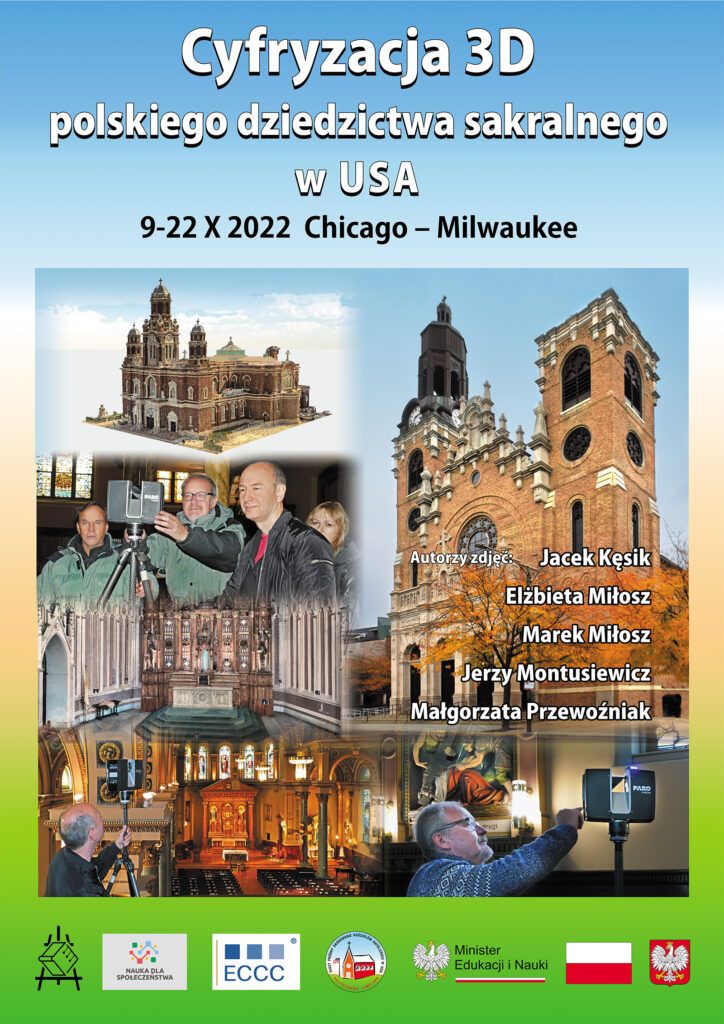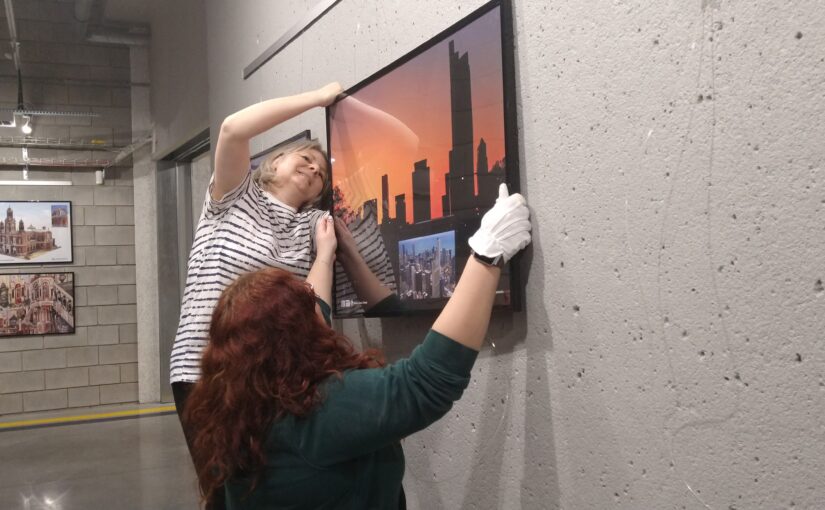Opening: January 27, 2023, 13:00
Place: Center of Innovation and New Technologies of the Lublin University of Technology, 3rd floor, building 13 on the campus map.
The exhibition will be open until March 10, 2023.
The curator of the exhibition is Prof. Jerzy Montusiewicz.
The presented photographic exhibition is a collective work of the participants of the first scientific expedition of the ECCC Foundation to the US, which took place on October 9-22, 2022. The expedition was carried out as part of the project entitled “Research on the national cultural heritage of the Polish community in the USA and the creation of digital memory collections” financed from the SCIENCE FOR THE SOCIETY program by the Ministry of Education and Science. The expedition operated in the cities where Poles settled from the end of the 19th century to the present, i.e. in Chicago (Illinois) and Milwaukee (Wisconsin).
The nature of the activities carried out during the expedition and the goals set for implementation required the creation of an interdisciplinary team. It was composed of employees from the Lublin University of Technology (Prof. Marek Miłosz – head of the expedition, Prof. Jerzy Montusiewicz, Dr. Jacek Kęsik, Dr. Elżbieta Miłosz) and the John Paul II Catholic University of Lublin (Lukasz Konopa, MA) and a representative of the ECCC Foundation (Małgorzata Przewoźniak, MA – project manager).
The team of the Lublin University of Technology consisted of four computer scientists representing the Department of Computer Science at the Faculty of Electrical Engineering and Computer Science. Since 2015, the participants of the expedition, along with other employees, have been dealing with the broadly understood 3D digitization of tangible and intangible cultural heritage – their archiving, reconstruction, as well as the dissemination of virtual and printed 3D models. These activities were carried out in Poland, Romania and on the Silk Road in the countries of Central Asia (Uzbekistan, Kazakhstan and Kyrgyzstan) as a part of the activity of the specialized laboratory “Lab 3D”.
The success of the entire undertaking depended on establishing personal contacts with the hosts of the churches. In most cases, the project manager, Małgorzata Przewoźnik and Łukasz Konopa, were directly responsible for these activities, but the Poles met there also joined in, including Mr. Damian Pogorzelski (“POGO”), an activist of the Polish community and at the same time an official of the city hall in Chicago.
During the first expedition, the team scanned six church buildings, which were funded by contributions from Poles living there. The work focused on activities aimed at preserving the three-dimensional appearance of these objects (interior and exterior) using the most modern model of the FARO Fokus terrestrial laser scanner and photogrammetry, as well as selected small architectural details and reliquaries.
3D scanning of the following active churches in Chicago was carried out: Basilica of St. Jack (hosted by Rev. Antoni Dziorek, CR – the assembly of the Resurrectionists, with the consent of the parish priest, Rev. Stanisław Jankowski, CR), the Holy Trinity Church (parish priest Rev. Andrzej Totzke from the assembly of the Society of Christ for Polish Diaspora, SChr), the church of St. Stanisław Kostka (with the consent of an employee of the office), the church of St. Hedwig (host – Fr. Tomasz Wojciechowski, CR). In addition, 3D digitization of the church of St. Michael the Archangel in Chicago (thanks to Mr. Hubert Cioromski), which was excluded from use in 2020 and subjected to desacralization. Currently, as a closed facility, it is intended for sale, and its future fate is currently unknown. During the expedition, a 3D scan of the church of St. Stanislaus Bishop and Martyr in Milwaukee (hosted by canon Benoît Jayr – from France), a city about 100 miles from Chicago.
Conducting field work was not easy, primarily due to the long commuting to the facilities, their very large size, changeable weather – which is famous for the windy city located on Lake Michigan, low temperatures inside the facilities, and over 8 hours of work with the equipment in scanned churches. Despite various problems and adversities, the team obtained 1.5 TB of data in the form of approximately 300 3D scans and tens of thousands of photos. The preliminary results of the expedition’s achievements can be viewed and studied at www.polskiedziedzictwo3d.pl
The photos of the exhibition show the participants of the expedition in various situations during their work: when setting up the equipment, 3D digitization using the Faro scanner, shooting panoramic films, taking photos, moving objects, creating descriptions, as well as during mundane life activities (lunches). In addition, the photographs show 3D printscreens of clouds inside the churches and their external volumes generated from scans, as well as 3D mesh models of selected objects. We also have photos from the parish festival in Holy Trinity, meetings with the teachers of the Polish Sunday school and its headmistress – Mrs. Maria Baran, with Fr. Bp. Piotr Turzyński – the delegate of the Polish Bishops’ Conference for the Ministry of Polish Emigration, as well as recording a broadcast on Polish Radio Chicago. There were also a few photos presenting the specificity of Chicago.
Authors of the photos:
Jerzy Montusiewicz – curator of the exhibition
Jacek Kęsik
Elizabeth Miłosz
Marek Miłosz
Malgorzata Przewoźniak


